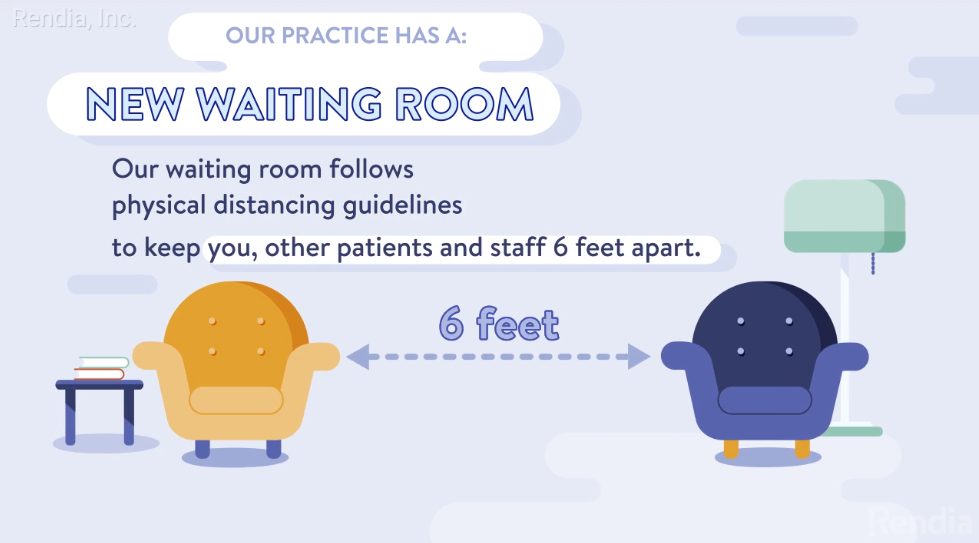How to welcome patients back and make them feel safe post-COVID-19
In our last post, we discussed tips to prepare your medical practice to reopen for routine appointments and elective procedures. Everything about health care has changed in light of the COVID-19 crisis—including how you open (or reopen) your doors to patients, and how you maintain strong doctor-patient interactions while wearing masks.
Here are six things to consider as your practice moves forward now.
Address patient fears.
It’s understandable that patients may be wary if not downright frightened about going to the doctor right now. After all, “Many of your patients have spent the last month consuming articles on how the coronavirus transmits, how long it lives on every surface known to man, and the relative efficacy of a N95 respirator vs. surgical mask,” noted PhysiciansPractice.com.
Patients want to know what your practice is doing to protect them. Ask patients what will make them feel safe, and communicate your new safety protocols before they step in the door.
Patients want to know what you are doing in your office to protect them. “So your staff has to be prepared to answer that question,” said Robert Davis, O.D., a practice owner in Florida, on the April 29 episode of The Power Hour optometry radio show. You should also communicate your practice’s new safety procedures on your website, social media platforms, and in your emails and texts to patients.
“It is also asking your patients, ‘what is it that makes you feel safe?’” James Milford, M.D., a family physician and practice owner in Wisconsin told the American Medical Association (AMA), adding that one patient noted not feeling safe opening the door.
“We installed automatic doors so that they don’t have to touch the doors,” he said. “We realized that in order to get people through our doors and to feel comfortable, we have to make them feel safe and be truthful about it.”
Move patient intake online.
A common theme among doctors is their intention to move everything possible online in order to minimize exposure and maximize in-person doctor-patient interactions. Dr. Davis now sends his patients online forms using IntakeQ.com so they can fill out their medical history at home and send it in ahead of time. “We don’t want these patients coming to the front desk and filling out forms,” he said.
Sending patients educational videos that they can watch before or after their appointments is another way to save time in the exam room and improve comprehension and adherence.
Let patients see your sanitizing procedures.
“In the past, patients trusted that their providers were doing what they needed to do to maintain a sanitary environment—that world has changed,” according to PhysiciansPractice.com. “Be transparent about your sanitation protocols. Make sure that they are visible the moment your patient walks in the door.”
“We actually have a sign in the examining room on the chair that says, ‘This room has been sterilized for your protection’,” said Dr. Davis. Other doctors mentioned that they now plan to disinfect equipment, eyeglass frames, bathrooms, etc. in view of patients to reassure them.
Think outside the mask.
One unfortunate consequence of doctors having to wear masks now is that “you lose that special communication with patients” when they can’t see your smile, noted Dr. Davis. You also may have to talk slower and repeat things, especially with older patients and those with hearing loss.
One workaround his practice is considering is going over patients’ history with them via Zoom or Facetime prior to the appointment “so we can have that conversation without masks on,” he said.
In the office, you might consider what some health care workers on the front lines have done: wear photo badges on their PPE to put their patients at ease. No laminated badges? Snap a photo of each staffer on your phone and pre-print them onto sheets of self-stick mailing labels. Each employee can simply stick a label onto their shirt each morning and discard at the end of the day.
Be proactive in scheduling patients.
Whether you’re facing an immediate backlog of patients or focused on ramping up routine care, consider reaching out to patients to let them know you’re resuming appointments and tell them about your new scheduling and safety procedures.
Reach out to patients to tell them you have reopened and invite them to schedule an appointment. Promote any new services you may be offering—telemedicine, special hours, dry eye care, etc.
Dr. Davis’ practice made a list of VIP patients—those who come in and buy a year’s supply of contact lenses, those who spend a lot of money in the optical department, glaucoma patients, macular degeneration patients—and reached out to them, he said. The doctors let these patients know how much they appreciate their business and that they would love to get the patients on the schedule since the practice won’t have as many openings going forward. “It’s amazing how many of these people thanked us for reaching out to them and made appointments.”
If you’re offering telemedicine appointments, promote that to patients who may want to see a doctor but prefer not to come into the office.
Make the most of your downtime.
Lastly, if business has slowed down temporarily, consider how you can enhance your practice’s offerings to attract more patients. Dr. Davis said, “We’re trying to improve our myopia control center, our dry eye center, we’re involved with sports vision and concussion protocol…And I think we have the time now, because we are slower, to improve our skills. I’m hoping that after all this is over, we’ll come out of this as better practitioners.”

